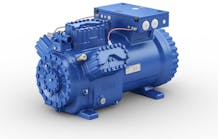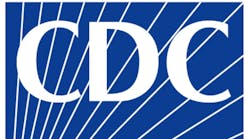In a significant development coinciding with ASHRAE's own release of its first-ever pathogen mitigation standard (draft), the Centers for Disease Control and Prevention (CDC) on May 12 updated its own key recommendations for raising indoor air quality (IAQ) in buildings via improved ventilation.
Among other important strategies, CDC now specifically recommends that buildings have "at least 5 air changes per hour of clean air in occupied spaces." The agency also says that the minimum filter recommendation for such spaces should now be MERV-13.
Taken together, the ASHRAE and CDC actions might put us "on the verge of an indoor air quality revolution and could be among the most important public health victories of the 21st century," writes Joseph G. Allen this week in a Washington Post op-ed. An associate professor in public health, Allen is director of Harvard University's Healthy Buildings Program. "This represents a monumental shift. The floor for minimum clean air standards is being raised, beginning to correct a mistake from several decades ago that has had disastrous consequences," he added.
For its part, The Washington Post's own editorial board also weighed in, calling the new CDC updates "pathbreaking new guidance" that "can make a difference the next time a novel virus strikes -- or even when a bad flu is going around." The editorial concluded by challenging readers. "Do you know the air exchanges per hour at your workplace or classroom? The CDC is now giving us a yardstick to measure by. Americans should use it."
Of note, the federal declaration of a Covid-19 Public Health Emergency (PHE) officially ended on May 11. The next day, CDC posted its updates. What follows are just some of those highlights. For the rest, click here.
Ventilation Mitigation Strategies
When indoors, ventilation mitigation strategies can help reduce viral particle concentration. The lower the concentration, the less likely viral particles can be inhaled into the lungs (potentially lowering the inhaled dose); contact eyes, nose, and mouth; or fall out of the air to accumulate on surfaces. Although it isn’t known exactly how much the concentration of viral particles in air needs to be reduced to start reducing risk of viral infection, ventilation mitigation strategies still provide a reasonable approach to reducing risk. Not all interventions will work in all scenarios and their selection must be carefully evaluated prior to adoption.
These ventilation interventions can reduce the spread of disease, but they will not eliminate risk completely. These interventions are intended to lower transmission risk by lowering the concentration of infectious aerosols in a room. However, the overall transmission reduction is less likely to apply to people who are very close (e.g. face-to-face) to the infectious source. Some of the following interventions are based on COVID-19 Technical Resources published by ASHRAE (a professional organization formerly known as the American Society of Heating, Refrigerating, and Air Conditioning Engineers).
- The Clean Air in Buildings Challenge is a national call to action that highlights a range of recommendations and resources available to assist with reducing risks from airborne viruses and other indoor contaminants. Create your clean indoor air action plan today.
In addition to buildings, vehicles – including public transportation such as buses, subways, trains, school buses, carpools, and rideshares – are also areas where ventilation improvements can be applied to reduce the spread of airborne viruses and lower the risk of exposure.
The recommendations presented here are not intended to replace guidance that may already exist in national, state, and local standards and guidelines. For example, some healthcare spaces have specified ventilation requirements intended to prevent and control infectious diseases. For spaces where existing standards and guidelines specify lower ventilation rates than the recommendations presented here, building owners and managers are encouraged to consider adoption of the more protective guidance.
- Important: For interventions listed below that are marked with “**,” consulting with professionals experienced in the proper selection, implementation, and commissioning of HVAC improvements is strongly encouraged. Their experience should preferably include the building, system, and occupancy types under evaluation. Other interventions may require similar consultation, depending upon the knowledge and experience of the individuals responsible for implementing changes to the building.
Improving Air Circulation
1. If you do nothing else, ensure existing HVAC systems are providing at least the minimum outdoor air ventilation requirement in accordance with ventilation design codes.
- Applicable codes are based on the year of building construction or latest renovation and intended building occupancy;
- Preferably, upgrade HVAC system performance to meet current ventilation code requirements at current occupancy levels;**
- This will develop a strong and lasting baseline upon which further interventions can be implemented.
2. Increase the introduction of outdoor air beyond code-minimum requirements.
This measure will potentially increase energy costs. Use of an energy recovery ventilator (ERV) can lessen the potential energy and system implications of increased outdoor air.
- Open the outdoor air dampers on your HVAC equipment beyond minimum settings to reduce or eliminate HVAC air recirculation. In mild weather, this will not affect thermal comfort or indoor humidity. However, this may be difficult to do in cold, hot, or humid weather.**
- Open windows and doors, when weather conditions allow, to increase outdoor air flow. Even a slightly open window can introduce beneficial outdoor air.
- Do not open windows and doors if doing so poses a safety or health risk (e.g., risk of falling, triggering asthma symptoms) to building occupants. Use caution in highly polluted areas when increasing outdoor air ventilation.
3. Use fans to increase the effectiveness of open windows.
- To safely achieve this, fan placement is important and will vary based on room configuration.
- Avoid placing fans in a way that could potentially cause contaminated air to flow directly from one person to another (see FAQ #11 below on indoor use of fans).
- One helpful strategy is to use a window fan, placed safely and securely in a window, to exhaust room air to the outdoors. This will help draw outdoor air into the room via other open windows and doors without generating strong room air currents. Similar results can be established in larger facilities using other fan systems, such as gable fans and roof ventilators.
4. Rebalance or adjust HVAC systems to increase total airflow to occupied spaces when possible.
- Increase total airflow to increase room air mixing and reduce viral particle concentration and subsequent exposure potential.**
- Turn off any demand-controlled ventilation (DCV) controls that reduce air supply based on occupancy or temperature during occupied hours.**
- In homes and buildings where the HVAC fan operation can be controlled at the thermostat, set the fan to the “on” position instead of “auto,” which will operate the fan continuously, even when heating or air conditioning is not required.
- Ensure restroom exhaust fans are functional and operating at full capacity when the building is occupied.
- Inspect and maintain exhaust ventilation systems in areas such as kitchens, cooking areas, etc. Operate these systems any time these spaces are occupied. Operating them even when the specific space is not occupied will increase overall ventilation within the occupied building.
- In non-residential settings where an infectious source was not known to have been present, run the HVAC system at maximum outside airflow for 2 hours, or until the building has achieved at least 3 air changes, after the building is no longer occupied. If an infectious source was present, see FAQ #2.
- Generate clean-to-less-clean air movement by evaluating and repositioning as necessary, the supply louvers, exhaust air grilles, and/or damper settings.** See FAQ #4 below on Directional Airflow. This recommendation is easier to accomplish when the supply and exhaust points are included as part of a “drop ceiling.”
Improving Air Cleanliness
1. Upgrade central HVAC filter efficiency to a Minimum Efficiency Reporting Value (MERV)-13 or better. When compatible with your HVAC system, increased filtration efficiency is especially helpful when enhanced outdoor air delivery options are limited.
2. Inspect HVAC systems.
- Ensure ventilation systems operate properly and are up to date on maintenance.
- Make sure air filters are properly sized and within their recommended service life.
- Inspect filter housing and racks to ensure appropriate filter fit and minimize air that flows around, instead of through, the filter.
3. Use portable or built-in high-efficiency particulate air (HEPA) fan/filtration systems (also called air cleaners or air purifiers).
- Use HEPA systems to enhance air cleaning (especially in higher risk areas such as a medical office or areas frequently inhabited by people with a higher likelihood of having COVID-19 and/or an increased risk of getting COVID-19). See FAQ #5 below on HEPA filters and in-room HEPA air cleaners.
- In-room air cleaners that use filters less efficient than HEPA filters also exist and can contribute to room air cleaning. However, they should be clearly labeled as non-HEPA units.
- Some air cleaners/air purifiers use technologies other than filtration. See FAQ #8 for a detailed discussion of factors to consider before using these other technologies.
4. Use UVGI (also called GUV) as a supplemental treatment to inactivate airborne viruses, such as SARS-CoV-2. UVGI can be effective in many spaces, but it is especially useful as an additional layer of protection to reduce infectious particles in indoor spaces that host large gatherings or where the risk of disease transmission is high. It is also helpful when options for increasing room ventilation and filtration beyond code requirements are limited.**
- Upper-room UVGI systems can be used to provide air treatment within occupied spaces.
- In-duct UVGI systems can help enhance air cleaning inside central ventilation systems.
- See detailed discussion in FAQs #6 and #7.
How Much Ventilation Is Enough?
Aim for 5 Air Changes per Hour (ACH)
When possible, aim for 5 or more air changes per hour (ACH) of clean air to help reduce the number of germs in the air.
This can be achieved through any combination of central ventilation system, natural ventilation, or additional devices that provide equivalent ACH (eACH†) to your existing ventilation. Supplying or exhausting an amount of air (use the larger of the two values but do not add them together) that is equal to all the air in a space is called an air change. Multiplying that amount by 5 and delivering it over one hour results in 5 ACH.
For more on calculating ACH and estimating related cost considerations, click here.
##########









